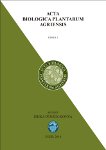About us
The Acta Biologica Plantarum Agriensis, a member of the Acta Academiae Paedagogicae Agriensis family of scientific journals, is published yearly by the Eszterházy University, Eger. This international journal contributes in all areas of plant biology, including anatomy, physiology, stress- and ecophysiology, biochemistry, biophysics, molecular biology, cell biology, genetics, ecology, taxonomy and geobotany.

ISSN 2061-6716 (Print)
ISSN 2063-6725 (Online)
Aims and Scope
We consider papers in any of the main areas of plant biology including anatomy, physiology, stress- and ecophysiology, biochemistry, biophysics, molecular biology, cell biology, genetics, ecology, taxonomy and geobotany. Type of published papers: research papers, review articles, and comments on published papers. Review articles should indicate fruitful areas of further research.
In order to submit a new article or to have information your submitted articles please enter your User ID and Password into the boxes below, then click "Log In".
If you need technical support, then send a mail to here please.
Submission of a manuscript to Acta Biologica Plantarum Agriensis automatically involves the assurance that it has not been published and will not be published elsewhere in the same form. Please, present the work concisely and clearly in English. Since poorly-written material will not be considered for publication therefore we recommend that you ask a native English lector to read over your manuscript before submission. There are no explicit length limitations: a normal research article will occupy 4-12 printed pages; reviews might be considerably longer.
All papers are peer-reviewed by two referees. For rapid reviewing, we encourage referees to send in their reports by e-mail.
Authors should submit the manuscript (text, tables and figures) electronically as an e-mail attachment. After the electronic submission authors should submit one set of the complete manuscript including drawings, photos and graphs by airmail. Only good-quality laser printouts will be accepted. All pages should be printed with full double spacing, 2.5 cm margins. A standard 12 point Times typeface should be used throughout the manuscript, with symbol font for Greek letters. Acta Academiae Paedagogicae Agriensis Sectio Biologiae will not return copies of submitted manuscripts. Requests to return original figures will be honoured as a courtesy, but cannot be guaranteed. If instructions are not followed, authors will be asked to retype their manuscripts.
Preparation of the manuscript
Page 1
Title page: Complete title, name of each author where the work was done; mailing address, phone, fax, and e-mail of the corresponding author; an abridged title of no more than 50 characters without spaces; keywords (no more than six).
- Title:
Make the title concise and informative, it should contain the main keywords. If a botanical name is included you should use italic letters and also mention the authority. - Authors:
You should include first name, initial and surnames for each authors and current mailing address for each. Provide e-mail address, facsimile and phone number in the case of corresponding author.
Page 2
Abstract: no more than 200 words. State the scope of the work and principal findings. Scientific name of plants here should not be accompanied by their authority. References in abstract should not be included.
Abbreviations used: The following terms are accepted and do not require explanation in the text of "abbreviations used": ADP, ATP, C3, C4, CAM, DNA, HPLC, NAD, NADH, NADP, NADPH, PS I, PS II, Rubisco.
In taxonomic text herbaria should be abbreviated according to the acronyms given in Index Herbariorum. Abbreviations of plant author names must follow Brummitt, R.K. & Powell, C.E. (1992), Royal Botanic Gardens, Kew. Plant names must conform to the actual International Code of Botanical Nomenclature. Citation of specimens should be selected, one or two per geographic units. Full distribution can be done on maps. Molecular sequence data must be made available from a public database associated to vaucher specimens in publicly available herbaria, with the collector’s name and collecting number.
Beginning on page 3
Introduction, Materials and Methods, Results, Discussion, Acknowledgments, References, Tables, Figure Legends, Figures.
The introduction should not exceed what is necessary to indicate the reason of the work and its essential scientific background, and the discussion should explain the significance of the results in connection with the international literature of the field. Results and discussion is also allowed.
References
In the text references should be cited chronologically; do not number them e.g. (Cornic 2000); (Tezara et al. 1999; Delfine et al. 2001; Lawlor and Cornic 2002; Centritto et al. 2003; Chaves et al. 2003). Where the same author has more than one publication in a year, lower case letters should be used (e.g. 1999a, 1999b, etc.). At the end of the paper, list the references in alphabetical order.
Examples:
Darkó, É., Váradi, G., Dulai, S., & Lehoczki, E. (1996). Atrazine-resistant biotypes of Conyza canadensis have altered fluorescence quenching and xanthophyll cycle pattern. Plant Physiology and Biochemistry 34: 843-852.
Dulai, S., Molnár, I., & Lehoczki, E. (1995). Heat-induced modulated chlorophyll a fluorescence changes in atrazine resistant and susceptible biotypes of Conyza canadensis (L.) Cronq. In P. Mathis (ed.): Photosynthesis: from Light to Biosphere. Vol. IV: 921-924. Kluwer, Dordrecht.
Please be sure that all cited references in the text are listed and vice versa.
Mathematical formulae, statistical analysis, units
Please avoid two-line mathematical expression in the running text and display each long formula on a new separate row.
You should describe the experimental design in sufficient detail to allow them evaluated. Please give the number of individuals, means and measures of variability. Give clearly whether you have used the standard deviation or the standard error of mean.
Please use the SI system where appropriate. However, non-SI units (e.g. day, year) are also acceptable. Photon flux density units are also acceptable for quantum efficiency of plant photo-processes. Do not use luminous flux density units (e.g. lux). The negative index system should be used (e.g. mol m-2 s-1, kg ha-1, etc.)
Chemical and enzyme nomenclature, instruments
The manufacturer’s name and location should be given in parentheses for reagents and instruments. Sources for all antibodies and nucleotide sequences should be indicated.
You should follow the recommendations of the IUPAC-IUB Commission on the Biochemical Nomenclature for naming compounds and the recommendation of the Nomenclature Committee of the International Union of Biochemistry on the Nomenclature and Classification of Enzymes as published in “Enzyme Nomenclature” (Academic Press: San Diego, 1992) for naming enzymes.
Illustrations
Please refer to every Figure, Map, or other illustration in the text. Number each with an Arabic numeral. Material in the legend should not be duplicated and methods should not be described. The first illustration in the text should be referred to as Fig. 1, Map 1, Photo 1, and so on. Using illustrations published by other authors can be applied only on the basis of the permission of the original publisher.
One complete set (figures, maps, photos), including a high-quality “original” for publication, must be submitted with the manuscript also by air (priority) mail. For the printed version the back of each figure, map or photograph plate should be labelled in soft lead pencil, indicating the figure number, the first author’s name and the orientation. If the illustrations are not available in electronic format, please send three sets in hard copy. Only black and white photos with high contrast and quality are published. In the case of line drawings please, make a point of using an adequate line thickness for the zooming.
Unsatisfactory illustrations will be returned for correction.
Tables
Tables should be numbered consecutively with Arabic numerals. A brief title should be included above the table. Avoid long titles by incorporating an explanatory note in the head note, which should be started on a new separate line below the title. Fore preparing the tables please use tabs (not spaces or hard returns) or prepare the tables in Microsoft Word format using Table Formatting (i.e. use table cells).
Proofs and reprints
Proofs will be sent in electronically to the corresponding authors in pdf format for checking prior to publication. Proofs should be checked and returned by fax as soon as possible after the checking.
Reprints are not provided. The published article will be sent to the authors as a pdf file.



Development of this Web site is realized as a part of the "EKF - a TermészetTudás Főiskolája", a successful tender project of New Hungary Development Plan TÁMOP 4.2.3: Recognition and dissemination of scientific results. The project is founded by the EU and is co-financed by the European Social Fund.
This web site is being developed by Tibor Juhász.
© 2010 Eszterházy Károly College. All rights reserved.



